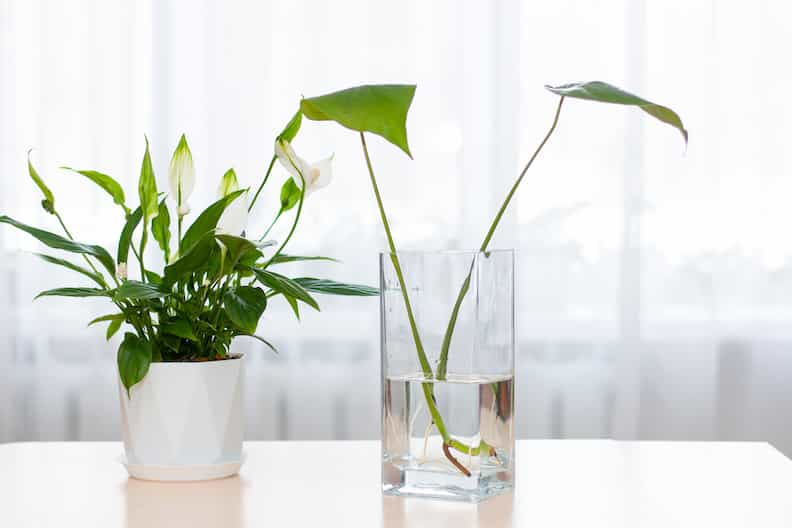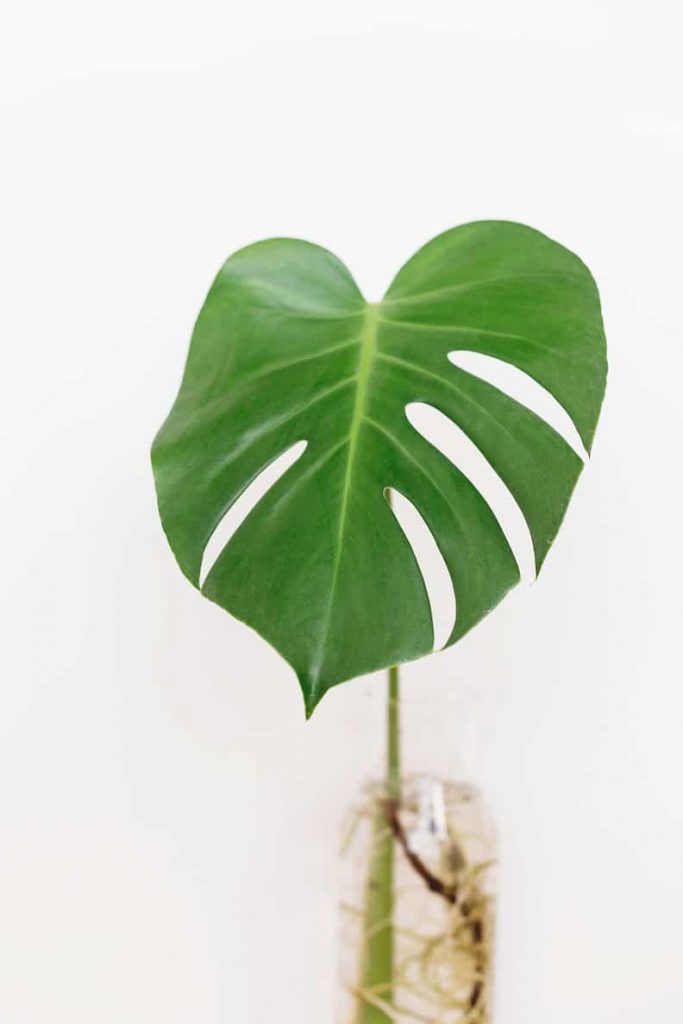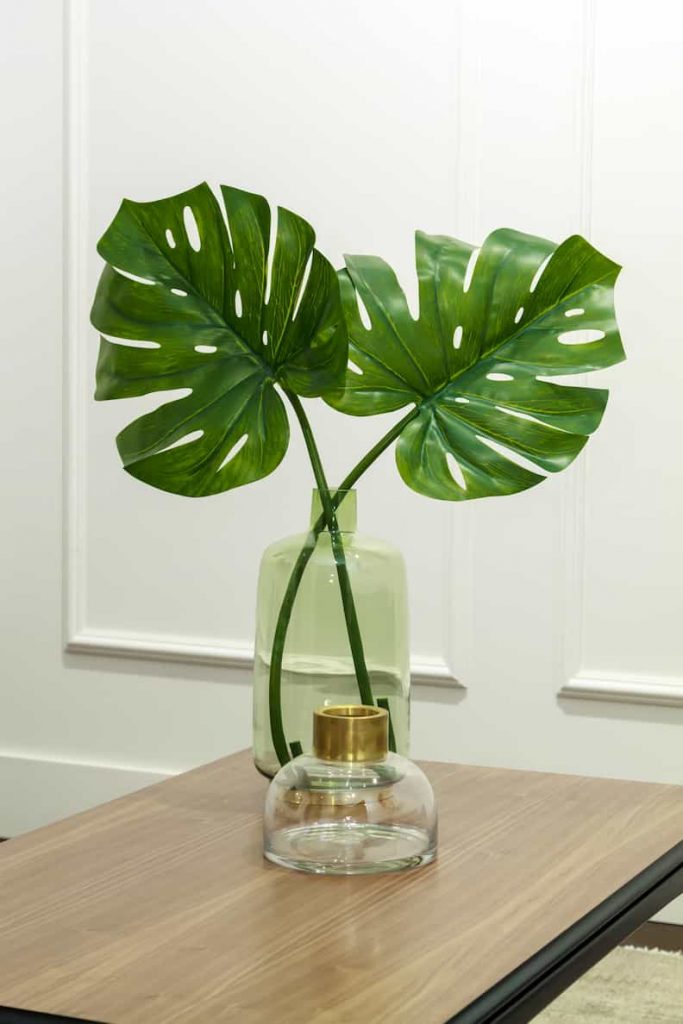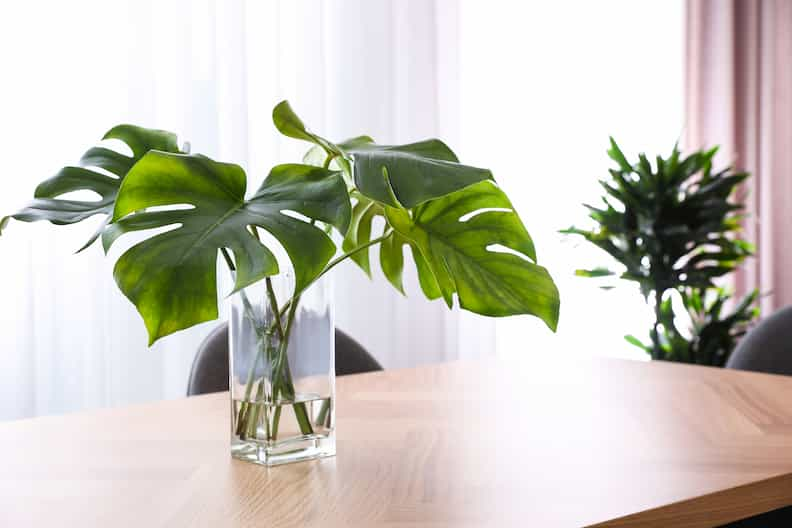Monsteras produce beautiful showy leaves filled with dramatic splits and holes, called fenestrations. These tropical climbers are often grown in soil and trained to climb a moss-covered pole. But many Monstera lovers struggle with knowing when to water them as they are prone to overwatering and root rot.
Growing your Monstera in water eliminates the stress of worrying about watering the plant. It’s also an added bonus that this technique is really straightforward and requires very little effort on your part.
It can also be a really simple yet effective decorating technique. There’s a reason that many home decor pins on Pinterest show someone grow a Monstera in water on, say, a minimally decorated coffee table.
Most Monstera plants will thrive growing in water as long as you give them the light they need and a little dash of fertilizer when they need it. Here’s how you can get your plant to do just that.

Table of Contents
How to Grow Monstera in Water
Growing a Monstera in water is easier than you think. These adaptable plants don’t really need soil as long as they are getting the water and nutrients they need.
There are two ways to grow a Monstera in water: from a cutting or by removing the plant from its pot and washing away the soil on its roots.
1. Place the rooted cutting or freshly washed Monstera in a large vase or container
Most people prefer a clear container in which to grow a Monstera in water, like a recycled plastic jug or a glass vase, so they can see the roots easily. This means you will know right away if there are problems with the roots.
Clear containers can be placed inside a decorative pot to keep the roots out of sight if you find them unattractive – although I have to say that I’m a fan of using a glass jug for this as it really emphasises the minimalist chicness of doing this! If, however, you prefer the dash of color that the outer pot provides, checking the roots is as simple as lifting the inner container to take a quick peek.
(You can find some more ideas on the best pot for your Monstera in our article on this.)
2. Fill the container about halfway with fresh water
Tap water can be used, but you should let it sit for 24 hours before using it. This allows chlorine and other chemical additives to evaporate from the water.
Distilled, filtered, or well water are generally better choices for growing your Monstera in wanter. If you choose to use well water, make sure it is not hard water. Hard water contains minerals, like magnesium, calcium, and iron, which may damage or weaken the roots of your Monstera.
3. Place your Monstera plant in bright light from a sunny window
Monsteras grown in water still have the same light requirements as those grown in soil and so prefer bright indirect light for several hours a day.
Avoid placing the plant in direct sunlight as it can damage the foliage and, in the case of Monsteras grown in water, direct sunlight can cause algae growth in the water.

4. Change the water in the container at least once every two weeks
Your plant gets the oxygen it needs directly from the water, but stagnant water lacks oxygen. This is why you need to change the water relatively frequently to add fresh oxygen to the water. Generally, you will need to do this every two weeks or any time the water looks cloudy or discolored.
Topping off the water as it evaporates is also important. This is one time when making a few splashes is actually good for the health of your plant.
When topping off water in the container, pour the water so that it bubbles and splashes to add even more life-giving oxygen to the reservoir of water. Alternately, inserting a straw into the water and blowing a few bubbles will help to oxygenate the water, too.
5. Clean the roots once a month
It may sound like a chore but cleaning the roots can be done when you change the water for your Monstera. Simply remove the plant from the container and rinse the roots with your kitchen sprayer. Large plants can be washed in the shower.
When doing so, check the roots for any signs of discoloration and trim away any damaged roots. If you notice a build-up of green algae around the roots, this is a good time to wash that away, too.
6. Fertilize your Monstera with hydroponic fertilizer
Regular houseplant fertilizer will not provide the nutrients a Monstera growing in water needs. Plants grown in soil access trace elements and nutrients found only in soil, while houseplant fertilizer provides nitrogen, phosphorus, and potassium.
Hydroponic fertilizer is made for plants grown in water and contains all the nutrients your water-grown Monstera plant needs. Follow the direction on the container to determine the amount and frequency of applying fertilizer to your Monstera.
Can Monstera live in water forever?
A Monstera can live in water forever as long as its other growing needs, like adequate nutrients (fertilizer), plenty of bright light, and warm temperatures, are met. Some Monstera lovers report growing their Monstera plant in water for years without problems.
That said, there haven’t been any experiments or scientific confirmation of this so, strictly speaking, no one knows for sure how long a Monstera plant can live in water. However, based on the experience of others who’ve tried this, it is reasonable to assume it can live in water for the life of the plant.

Do Monsteras in water need fertilizer?
Monstera plants grown in water need hydroponic fertilizer to meet their needs. Hydroponic fertilizer is designed for plants that grow in water and contains all the trace elements they need to thrive.
Plants grown in the soil absorb trace elements from the soil, along with the three macronutrients nitrogen, phosphorus, and potassium provided with houseplant fertilizer. Plants grown in soil cannot get the trace elements they need for healthy growth from water alone.
You can buy hydroponic fertilizer at plant centers, grow shops, and home improvement centers. Flora Grow, Fox Farm, and Plant Earth sell hydroponic solutions suitable for use when growing your Monstera plant in water.
How long can you leave Monstera in water?
You can leave your Monstera in water indefinitely as long as you meet its growing needs. This includes giving your Monstera the light it needs, proper nutrients, and you avoid sudden changes in temperature.
Keep in mind that a glass or vase of water will heat up quickly when left in the sun and may damage the roots of your Monstera plant, so be very aware of where you place a Monstera that’s growing in water.
Can a Monstera root in water?
Monstera plants can be rooted in water as long as they have at least one node. A node is a spot on the stem that contains the cells needed to sprout new growth. Leaves and aerial roots grow from nodes. When the cutting is rooted in water, the new roots sprout from a node too.
Finding a node on your Monstera’s stem is easy. Look for a section where a leaf or aerial root comes off the main stem. Sometimes, a node will have the remnants of an old leaf instead. The node is thickened, slightly rough, and may form a ring around the stem.
To root a Monstera cutting in water, you need to make the cut about ¼ to ½ inch below the node. When inserted in water, the node will sprout new roots in a week or two.

Propagating Monstera in water
Propagating a Monstera cutting in water requires a viable cutting and a glass or vase of freshwater. Here’s how to do it.
1. Locate a node on the stem of the Monstera plant containing one or two leaves
You can’t propagate Monstera without a node as your Monstera cutting will not root and develop into a new plant without a node. The node is the only place on the plant where it contains the cells necessary to create new growth.
A leaf or two is necessary for the plant to perform photosynthesis and manufacture energy for the plant to grow and form new roots.
2. Make a clean cut ¼ to 12/ inch below the node with a pair of sterilized garden clippers or a sharp knife
Using sterilized tools prevents the spreading of diseases from one plant to another. Get into a habit of sterilizing your cutting tools after each use. You can wipe them down with alcohol or use a solution of one part household bleach mixed with nine parts water.
3. Place the cutting of your Monstera in a water vase or glass filled with fresh water so that the node is in the water
Distilled or filtered water is best, but if you want to use tap water let it sit out overnight to rid it of chlorine and other additives in municipal water.
4. Place the cutting on a sunny windowsill where it will receive bright light
Avoid placing the cutting where it will receive direct sunlight as direct sunlight can damage the leaves and heat up the water and damage the new roots.
5. Change the water every 3 to 5 days or anytime it looks discolored or cloudy
Keeping the water changed is important as the roots and stem can decay if the water gets stagnant. Changing the water ensures the water has enough oxygen for roots to sprout and grow.
6. Pot the cutting in soil when the roots are 2 to 4 inches long
Many Monstera lovers prefer to pot their Monstera plants in Monstera potting mix, but they can be grown in water if you prefer.
Can Monstera water propagation lead to root rot?
The roots of a Monstera plant can rot in the water if it gets stagnant or is not changed to give the cutting the oxygen it needs. Stems are also susceptible to rotting when left unattended in a glass of water.
However, true root rot is a disease often caused by wet or soggy soil. Fungi that thrive in wet soil can attack the roots and turn them to mush.
There is no reason to think a Monstera cutting rooted in water is more susceptible to root rot in the soil, as long as it is healthy when you pot it, you use fresh potting mix, and you do not overwater the Monstera.
Does Monstera grow faster in water?
A Monstera will not grow faster in water at first. Instead, many show delayed growth for several months as they adjust to their aquatic environment. However, once they mature, a Monstera grown in water and one grown in soil tend to grow at a similar rate.
That said, this isn’t a universally held opinion, with some actually saying that this isn’t true. As such, it’s probably safer to assume that a Monstera grown in water will definitely grow…but if you also have one in soil, it’s perfectly normal for them to grow at different rates.
How do you transfer Monstera from water to soil?
Potting your Monstera cutting after it has rooted in water is a straightforward task. Follow these steps for transferring your Monstera from water to soil.
- Fill a plant pot about ½ to ¾ full of potting mix, depending on the size of the cutting.
- Position the cutting into the soil so the roots spread out over the surface.
- Fill in around the roots with fresh soil.
- Adjust the height of the cutting so that the roots are securely under the soil and the plant rests at the soil level.
- Pat or firm the soil around the base of the cutting to hold it securely in place.
- Water the new plant thoroughly to moisten the soil.
- Place the new Monstera plant in a location that receives bright, indirect light.
- Allow the soil to dry out so that the top 1 to 2 inches of the soil feels dry to the touch before watering your Monstera plant again.
- Resume your normal Monstera care routine.
Should I put my Monstera aerial roots in water?
Putting aerial roots in water won’t hurt your Monstera cutting and may even help with sprouting strong roots. Although aerial roots grow off the stems of the plant and are capable of getting moisture and nutrients from the air, they can sprout new underground roots, too.
That means aerial roots on your Monstera cutting will sprout the fine roots that typically grow underground when they are in the water. These roots are the roots you need when you transplant your Monstera plant to the soil.
Can you put Monstera in a fish tank?
Monstera plants can be grown successfully in a fish tank as long as the leaves and stems are above the water and the roots are allowed to grow down into the tank.
When grown in a fish tank with fish, the roots of the Monstera plants get their nutrients from the waste in the water. This works as a win/win situation as the fish wastes feed the Monstera plant and the Monstera’s roots clean the waste from the water. Specifically, Monstera removes nitrates from the aquarium water.
You do need to secure the Monstera with a stake, such as by attaching a wooden stake or other structure to the back or sides of the tank (a wooden stake erected on the outside of the tank works well) to hold the Monstera stems and leaves above the water level.

How do you root Monstera deliciosa in water?
Monstera deliciosa cutting can be rooted in water on a sunny windowsill. Here’s what you need to do.
- Select a healthy stem cutting containing at least one plant node and one to two healthy leaves. Plant nodes are the only place on your Monstera plant that will produce new growth. Leaves and aerial roots grow at the plant nodes. Nodes look thicker and may form a ring around the stem.
- Cut the stem about ½ inch below the node with a sharp pair of scissors or garden clippers.
- Place the cutting into a glass of fresh water so the stem and node are below the surface and the stem and leaves are above the surface.
- Change the water every 3 to 5 days or whenever it begins to look cloudy or discolored.
- Watch for new roots to form in a week or two.
- Pot the rooted cuttings in a good Monstera soil mix and water it thoroughly.
- Place the new Monstera deliciosa plant in a location that receives bright indirect light and resume normal Monstera care.
Pros of growing Monstera in water
Many enjoy growing Monsteras in water for several reasons:
- Convenience. Monstera plants grown in water are easy to care for and don’t require working with messy potting soil.
- Visible roots. Monstera plants are prone to root rot when grown in the soil, especially if they are overwatered. This often requires removing them from the pot to check the roots to be sure. When you grow Monsteras in water the roots are visible allowing you to monitor them and alerting you to any problems right away.
- No watering involved. When you grow Monstera in the water you don’t need to constantly check the moisture of the soil or remember how often to water your Monstera.
- No repotting. Repotting a Monstera can be a challenge, but it is a breeze when you grow it in water. Simply fill a larger container with water and pop the plant in its new home.
Cons of Growing Monstera in Water
There are some drawbacks to growing Monstera plants in water, but they can be easily rectified.
- Visually unappealing. Visible roots in a clear container may not be your own sense of style. But you can fix that in a hurry. Place the container inside a decorative pot or basket to keep the roots out of view. Lift the pot and check the roots whenever you want.
- Difficult to stake. Water won’t support a stake or moss pole like soil will, but don’t let that change your mind about growing your Monstera plant in water. Attach a stake to the outside of the container to give your Monstera a moss pole or similar support to climb.
- Algae. A plant growing in water, especially if it is in bright light, is an invitation to algae to grow. This is easy to solve, too. Place the container inside a light-proof container or pot to prevent sunlight from shining directly into the water.
Frequent water changes and a little elbow grease to scrub the algae away may be needed to keep your container looking good.
Growing your Monstera in water can be a lot of fun and may even be easier than growing it in the soil. While there is no guarantee the plant will perform better in water, many Monstera lovers seem to think so. Why not take a chance and try your hand at growing a Monstera in water and find out for yourself which is the best method for you?
